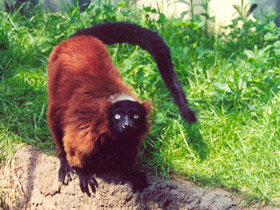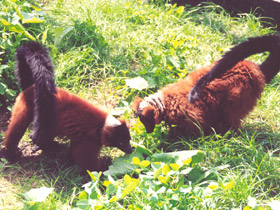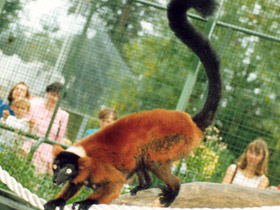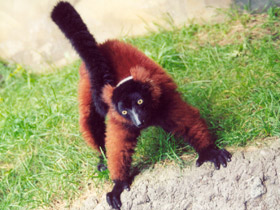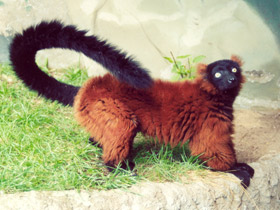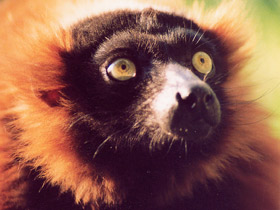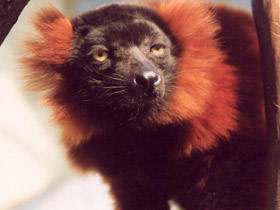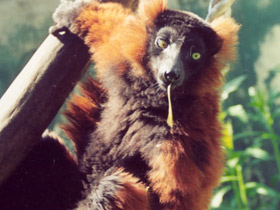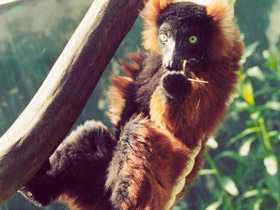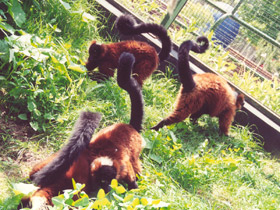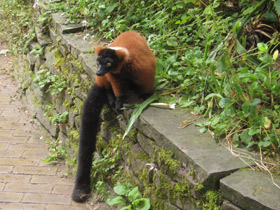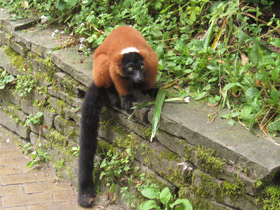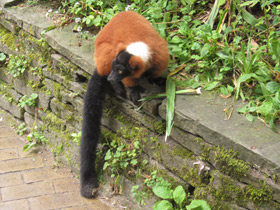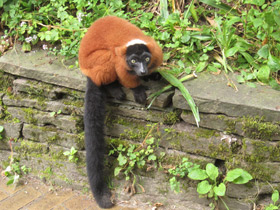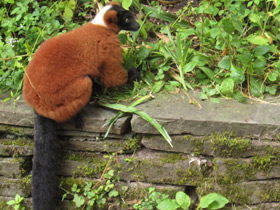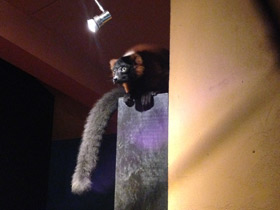The red ruffed lemur (Varecia rubra)
 The red ruffed lemur (Varecia rubra) is included in the IUCN Red List as "endangered"
The red ruffed lemur (Varecia rubra) is included in the IUCN Red List as "endangered"
The red ruffed lemur (Varecia rubra) is one of two species in the genus Varecia, the ruffed lemurs; the other is the black-and-white ruffed lemur (Varecia variegata). Like all lemurs, it is native to Madagascar. It occurs only in the rainforests of Masoala, in the northeast of the island.
Description and habitat
Varecia rubra is a species of strepsirrhine primate in the family Lemuridae. It is listed as one of the 25 most endangered primates in the world.
The red rufous lemur (Varecia rubra) is the second largest lemur in Madagascar after its closest relative, the black-and-white lemur: its body length reaches 55 cm and it weighs between 3.5 and 4.5 kg. Females are noticeably larger than males and can weigh up to 5 kg, of which 1 kg is due to the luxurious 60 cm tail. The body and limbs of the red lemur are covered with thick, beautiful red fur; the pointed snout, tail, hands and toes are black.
This animal can only be found in the tropical forests of the Masoala National Park, located in northeastern Madagascar, at an altitude of 1000 metres above sea level. The Varecia rubra spends its entire life in trees over ten metres high, moving not only on the branches but also jumping very skilfully from tree to tree (its long, thick tail is an excellent balancer).
Lifestyle and feeding
Varecia rubra leads a diurnal lifestyle and lives in unstable associations of 2 to 20 animals, the composition of which sometimes changes even during the day. In this case, the females are always the leaders of the group, and the group itself is built in conditions of a clear hierarchy. Females have the exclusive right to choose a mate and a place to gather food. The territory occupied by a group depends on the number of individuals in the group and can be as large as 0.3 ha. Varecia rubra is very aggressive towards members of other groups.
The diet of these brightly coloured half-monkeys includes more fruit than any other lemur species; they also eat flowers, leaves and young shoots, and tend to feed in the upper levels of the forest. Pregnancy in Varecia rubra lasts about 100 days, and 2-4 (and sometimes up to 6) young are born.
Reproduction
Varecia rubra are the only primates that can give birth to so many young. The female has six teats and is able to suckle her entire litter. Unlike the females of other primates, Varecia rubra do not carry their young on their backs when foraging for food. For the first three weeks, they leave their young in special shelters made of tree leaves. Females build the nest in tree branches and line it with their own fur. The young of these lemurs cannot cling to the female's fur, so, if necessary, she carries them between her teeth. For almost two months, the female does not allow anyone near the young, including the male. The young remain in the nest for 3-4 months and during this time the female feeds them with milk.
Varecia rubra in the Red Data Book
Varecia rubra is included in the IUCN Red List as Critically Endangered.

















